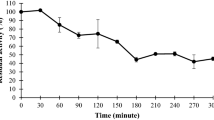Abstract
Enzymes are stereospecific, environmentally friendly, and energy-efficient alternatives to chemical treatments in the textile industry. In traditional applications, enzymes are employed to catalyze the process and then drained out on completion of the process. Despite their many potential applications in textiles, enzymes find a limited level of industrial acceptability. Immobilization is a technique for stabilizing enzymes, extending their useful life, and ensuring the long-term viability of their applications through recovery and reuse. In this work, the feasibility of immobilized enzymes for the complete cotton fabric pre-treatment was studied to develop a sustainable way of enzyme application for multiple cycles. Commercial amylase, pectinase and glucose-oxidase enzymes were covalently immobilized on reversibly soluble-insoluble polymer supports (Chitosan & Eudragit S-100) and utilized for the complete pre-treatment of cotton fabric. Methylene blue exhaustion, wax content and tegewa testing confirm the removal of impurities from grey cotton fabric using immobilized enzymes. The equivalent absorbency and whiteness were observed in samples up to three consecutive cycles of immobilized enzyme reuse. Furthermore, the equivalent uniformity, colour yield and fastness ratings after reactive dyeing of these pretreated samples also confirm that the immobilized enzymes can be reused for multiple cycles in comparison to native enzymes for industrial commercialization.
Similar content being viewed by others
References
S. R. Karmakar, “Chemical Technology in the Pretreatment Processes of Textiles”, Elsevier Science B V, Amsterdam, Netherlands, 1999.
A. Cavaco-Paulo and G. M. Gubitz in “Textile Processing with Enzymes”, 1st ed. (A. Cavaco-Paulo and G. M. Gubitz Eds.), pp.86–119, Woodhead Publishing Ltd., Cambridge, England, 2003.
D. Saravanan, A. A. Prakash, D. Jagadeeshwaran, G. Nalankilli, T. Ramachandran, and C. Prabakaran, Indian J. Fibre Text. Res., 36, 253 (2011).
S. N. Sreelaakshmi, A. Paul, N. S. Vasanthi, and D. Sarvanan, J. Text. Inst., 105, 59 (2014).
P. Anis and H. K. Eren, AATCC Rev., 2, 22 (2002).
J. N. Etters, Text. Chem. Color. Am. Dyest. Rep., 1, 33 (1999).
R. B. Waddell, AATCC Rev., 2, 28 (2002).
P. F. Tavcer, Tekstilec, 50, 16 (2007).
S. Ali, Z. Khatri, A. Khatri, and A. Tanwari, J. Cleaner Prod., 66, 562 (2014).
P. Anis, A. Davulcu, and H. A. Eren, Fibres Text. East. Eur., 17, 87 (2009).
G. Buschle-Diller, X. D. Yang, and R. Yamamoto, Text. Res. J., 71, 388 (2001).
A. Farooq, S. Ali, N. Abbas, G. L. Fatima, and M. A. Ashraf, J. Cleaner Prod., 42, 167 (2013).
D. Saravanan, N. S. Vasanthi, K. S. Raja, A. Das, and T. Ramachandran, Indian J. Fibre Text. Res., 35, 281 (2010).
Y. Shin, S. Hwang, and I. Ahn, J. Ind. Eng. Chem., 10, 577 (2004).
P. F. Tavcer, Biocatal. Biotransform., 30, 20 (2012).
R. Araujo, M. Casal, and A. Cavaco-Paulo, Biocatal. Biotransform., 26, 332 (2008).
R. Doshil and V. Shelke, Indian J. Fibre Text. Res., 26, 202 (2001).
S. Hossain and K. Uddin, Int. J. Eng., 11, 16 (2011).
K. Mojsov, II International Congress “Engineering, Ecology and Materials in the Processing Industry”, p.230, Jahorina, Proceedings, 2011.
K. D. Mojsov, Advanced Technologies, 3, 135 (2014).
P. Binod, P. Palkhiwala, R. Gaikaiwari, K. M. Nampoothiri, A. Duggal, K. Dey, and A. Pandey, J. Sci. Ind. Res., 72, 271 (2013).
G. D. Haki and S. K. Rakshit, Bioresour. Technol., 89, 17 (2003).
P. H. Nielsen, H. Kuilderd, W. Zhou, and X. Lu in “Sustainable Textile: Life Cycle and Environment Impact”, 1st ed. (R. S. Blackburn Ed.), pp.113–138, Woodhead Publishing Ltd., Cambridge, UK, 2009.
B. Brena, P. Gonzalez-Pambo and F. Batista-Viera in “Immobilization of Enzymes and Cells”, 2nd ed. (J. M. Guisan Ed.), pp.15–30, Humana Press Inc., Totowa, NJ, 2006.
R. A. Sheldon, Adv. Synth. Catal., 349, 1289 (2007).
A. Madhu and J. N. Chakraborty, J. Cleaner Prod., 145, 114 (2017).
A. A. Khan and M. A. Alzohairy, Res. J. Biological Sci., 5, 565 (2010).
J. C. Soares, P. R. Moreira, A. C. Queiroga, J. E. Morgado, F. X. Malcata, and M. E. Pintado, Biocatal. Biotransform., 29, 223 (2011).
K. Opwis, D. Knittel, A. Kele, and E. Schollmeyer, Starch, 51, 348 (1999).
T. Tzanov, S. A. Costa, G. M. Gubitz, and A. Cavaco-Paulo, J. Biotechnol., 93, 87 (2002).
V. S. Kumar, S. Meenakshisundaram, and N. Selvakumar, J. Text. Inst., 99, 339 (2008).
N. K. Pazarlioglu, M. Sariisik, and A. Telefoncu, Process Biochem., 40, 767 (2005).
Y. Yu, J. Yuan, Q. Wang, X. Fan, X. Ni, P. Wang, and L. Cui, Carbohydr. Polym., 95, 675 (2013).
C. J. S. M. Silva, Q. Zhang, J. Shen, and A. Cavaco-Paulo, Enzyme Microb. Technol., 39, 634 (2006).
J. Shen, M. Rushforth, A. Cavaco-Paulo, G. Guebitz, and H. Lenting, Enzyme Microb. Technol., 40, 1656 (2007).
B. Y. Sahinbaskan and M. V. Kahraman, Starch, 63, 154 (2011).
A. Madhu and J. N. Chakraborty, Res. J. Text. Apparel, 22, 271 (2018).
A. Madhu and J. N. Chakraborty, AATCC J. Res., 6, 7 (2019).
AATCC Test Method 79–2000, “Absorbency of Textile”, AATCC Technical Manual, AATCC, NC, USA, 2010.
S. D. Bhattachary and S. R. Shah, Color. Technol., 118, 295 (2002).
K. Sawada, S. Tokino, M. Ueda, and X. Y. Wang, Color. Technol., 114, 333 (1998).
Author information
Authors and Affiliations
Corresponding author
Rights and permissions
About this article
Cite this article
Madhu, A., Chakraborty, J. Sustainable Approach for Cotton Fabric Pretreatment with Immobilized Enzymes. Fibers Polym 23, 993–1007 (2022). https://doi.org/10.1007/s12221-022-4193-1
Received:
Revised:
Accepted:
Published:
Issue Date:
DOI: https://doi.org/10.1007/s12221-022-4193-1




